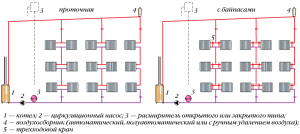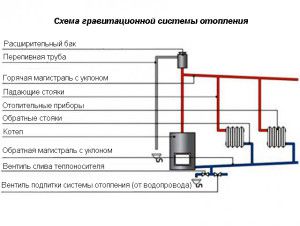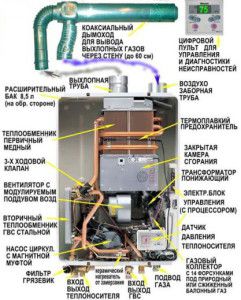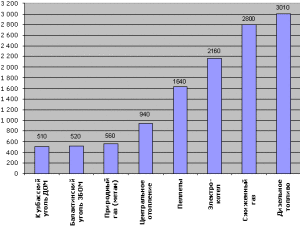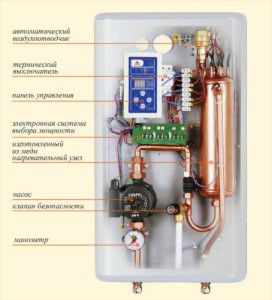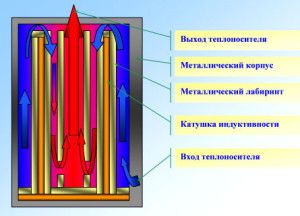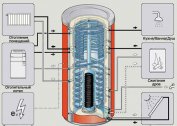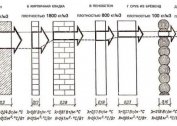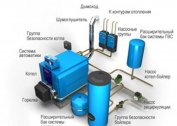When choosing a specific heating scheme, one should proceed from the principle of expediency and compliance with the operational characteristics of the house. For rooms with a small area, it is important to strike a balance between the total cost of the elements, work efficiency and planned costs. Therefore, a flow heating system is most often installed: boilers, heaters, pumps for which must be selected according to certain requirements.
Features of the flow heating circuit
What is the specificity of arranging the selection of components for this system? The flow-through heating system is primarily characterized by the rules for connecting radiators and other heating appliances. They are mounted in series, as a result of which the energy from the coolant is distributed in the same order.
Based on this, it is seen that the degree of heating of the first radiator connected to the flow heating boiler will be significantly higher than that of the last. In addition, the following features should be considered:
- Selected electric flow heating boilers must have a relatively high power. In most cases, the ratio of 1 kW of energy per 10 m2 of area will be wrong. From the figure obtained, it is necessary to add from 15% to 30%, depending on the length of the highway and the degree of thermal insulation of the house;
- Inability to control the heating level for each radiator. In this case, the volume of incoming coolant in subsequent batteries will decrease. This may cause the flow heater to be able to provide heat to all rooms in the house;
- Increased hydrodynamic drag. Even powerful flow heating pumps will not be able to create the proper fluid circulation rate due to the large number of radiators. Therefore, a one-pipe flow heating system needs careful calculation.
However, in addition to these shortcomings, the positive aspects of using such a scheme must be taken into account. The main one is the minimum cost when purchasing components. Serial connection of system elements does not provide for an additional circuit of the main line as in two-pipe heating.
When calculating a single-tube flow system, the diameter of the line must be taken into account. The larger it is, the lower the hydrodynamic drag index.
Types of instantaneous heating
One of the most important steps in choosing a heating scheme is its appearance. The movement of the coolant can be carried out by gravity (gravity) or using pumping equipment (forced). This affects the operational and quality characteristics of the heating system of a house or apartment. Consider the features of each of these schemes.
Gravity heating
The simplest flow system is made gravitational. For its organization, flowing heating boilers, an expansion tank of open type or a membrane are necessary. The heat carrier transport line is a pipeline that delivers water to radiators and a boiler for reheating it.
The main element is a flow boiler for heating. It should provide the optimum level of temperature. It is from him in the future that the speed of water circulation in the pipes will depend. When the coolant is heated, it expands, as a result of which it begins to move along the highway. As it passes through the pipes of the radiators, the water temperature begins to fall.The cooled liquid flows back to the boiler for reheating.
The features of the gravitational flow heating system include the following:
- The small length of the pipeline is up to 30 m. This is explained by low circulation pressure;
- A flowing electric boiler for heating is rarely used for this circuit. Most often, solid fuel models are preferred;
- High degree of inertia. The speed of passage of hot water through the pipes directly depends on the parameters of the boiler, the presence in the circuit of rotary units and branches. Therefore, heating of radiators in rooms far from the boiler will be relatively slow.
Most often, the gravitational flow heating scheme is used for small houses or apartments. The positive qualities include its relatively low cost, as well as the ability to install a small flow heater for heating the house.
To create water circulation after exiting the boiler, a vertical riser is installed, the height of which should not exceed 5 meters. The heated liquid creates the desired pressure indicator for further movement of the coolant.
Heating with forced circulation pumps
To improve performance, a circulation pump is added to the flow-through heating system circuit. This contributes to the fastest speed of movement of water, which reduces the rate of inertia. Most often, high pressure is created in the line up to 3 atm. As a result, the boiling point of water rises, and the likelihood of air congestion is reduced.
If there is no main gas in the house or apartment, an electric flow heating boiler is most often installed. Their advantage lies in the possibility of choosing both single-circuit models (only for heating) and dual-circuit models (heating and hot water).
Since the forced circulation system in most cases is closed, installation of additional equipment should be considered. The main one is a sealed expansion tank installed on the return pipe in front of the heating boiler. Pressure gauges and thermometers are also mounted. At the same time, the flowing heating boiler should have similar devices. The result is an effective system for maintaining a comfortable temperature in the house with the following distinctive characteristics:
- Low degree of inertia;
- Subject to the installation technology and the selection of components, a long, non-repairable life is ensured;
- The ability to create a temperature regime at the maximum level - 95/60 degrees;
- No need to mount an accelerating riser, mandatory for gravity heating.
The disadvantages of heating with forced circulation include increased requirements for pipes and radiators. They must withstand the maximum allowable pressure and the set temperature operating mode. This scheme is applicable for houses with a large area of up to three floors.
When creating a circuit with forced circulation, it is recommended to purchase dual-circuit heating boilers of electric flow type. Even if the house has a hot water system - you can use the extra as a backup. The difference in cost between single-circuit and dual-circuit models is small - about 10-15%.
Choosing a flow heating boiler
Having decided on the type of system, you need to choose the right flow heating boiler. It is from its parameters that efficiency and the efficiency indicator will depend. The main difference for them is the type of fuel used. Currently, manufacturers offer solid fuel models that operate on gas or liquid fuel. Electric boilers are no less popular.
In addition, there are general recommendations for choosing a flow boiler for heating:
- Rated power.There are two ways to calculate this parameter - depending on the quadrature of the room or the total volume of the coolant. In the first case, the power of the flow heater for heating a house should correspond to a ratio of 1 kW of energy - 15 liters of water. With normal thermal insulation of the exterior walls of the house, you can also take into account that to maintain a comfortable temperature of 10 square meters. 1 kW of power is needed;
- The presence of a second circuit. It serves for hot water supply and is more than relevant when organizing heating in a private house;
- Dimensions and requirements for the room where flow heating boilers will be installed. For solid fuel, it is necessary to make a separate boiler room that meets the standards of DBN B.2.5-20-200. Gas and electric models can be installed in the kitchen, but only if their power does not exceed 200 kW;
- Ability to connect to external temperature sensors to automatically control the degree of water heating. This is necessary to optimize the flow of energy, which directly depends on the temperature in the room and on the street;
- The presence in the body of the flow heating pump and expansion tank.
These are just general recommendations for choosing a flow boiler for heating. Despite the popularity of gas and solid fuel models, attention is paid to electric ones. Although they have a number of unique qualities.
Along with foreign manufacturers, there are currently a number of Russian companies producing reliable boilers for flow heating systems: Romstar, Galan and Evan. Their products are significantly lower in price, and functional qualities and performance are more than acceptable.
Electric boiler for instant heating
First you need to find out the relevance of installing this type of heating equipment. The advantages of flowing electric boilers for heating lies in their small size. Unlike solid-fuel or gas types, in electric there is no combustion chamber as such. This affects their size and weight. It should also be noted the reliability of the equipment. The average service life can be from 20 to 40 years. But this is subject to operating rules.
The main disadvantage of an electric flow heating boiler is the high cost of energy. Therefore, it is installed only in the absence of a gas pipeline and as an alternative to solid fuel models. To select electric flow heating boilers, their types should be considered. The specific design depends on the type of heaters.
TEN
The heater is used as the main heating element. Inside the sealed tube is a spiral wire made of metal with a high resistance index. When electric energy is supplied, thermal energy is released, as a result of which the heater for heating of the eastern type begins to increase the temperature of the water.
The design consists of the following blocks:
- Heating unit. It contains a heater, which is washed by the heating medium;
- Control block. Designed for manual or automatic adjustment of the power of the heater;
- Air vent. Not all manufacturers install this security feature. But in case of overheating of the coolant in the flowing boiler during heating operation, the air vent will quickly remove the air plug;
- Additional accessories - circulation pump, pressure gauge, automatic shutdown system in the absence of water.
Also, when choosing, you need to pay attention to the manufacturers of a flow heater, designed for heating a house. The most popular brands are Bosch, Protherm and Dakon products.
| Model | power, kWt | Cost, rub. |
| Bosch Tronic 5000 H | 18 | 63800 |
| Bosch Tronic 5000 H | 36 | 90500 |
| DAKON DALINE PTE 10 | 10 | 53560 |
| DAKON DALINE PTE 24 | 24 | 62000 |
| PROTHERM SKAT 12K | 12 | 46410 |
| PROTHERM SKAT 24K | 24 | 57450 |
An important factor is the guarantee from the manufacturer and the availability of service centers for the operational repair of a flow heater for heating. It is recommended that you find out this information before your purchase.
Induction flow heating boiler
This is a relatively new type of flowing electric boiler designed for heating small rooms. Its advantage is small overall dimensions, reliable operation.
An electromagnetic coil is provided in the design for heating water. Inside it is the core. When connected to the mains, an electromagnetic field is created that provokes the heating of the core. In turn, it is washed by the flow of coolant. Thus, the water is heated using an induction flow boiler for heating.
The advantages of installing this equipment are as follows:
- Small dimensions and weight. They are smaller even compared to models equipped with heating elements;
- The efficiency of the device can reach 99%;
- Durability and reliability.
However, along with this, their main disadvantage is their high cost. It is not always advisable to buy a 10 kW boiler at a price of 45 thousand rubles for a one-pipe flow heating system. It should be borne in mind that the circulation pump and the expansion tank will not be included in the package.
| Model | power, kWt | Cost, rub. |
| VIN-10 | 10 | 45000 |
| VIN-25 | 25 | 60000 |
| Miratron | 12 | 60000 |
| Miratron | 24 | 85000 |
What else is needed to create a flow heating system in addition to boilers and heaters. Pumps are also an indispensable element for the forced circulation of water. Their power directly depends on the calculated hydrodynamic resistance. Therefore, before buying a flow pump for heating, you need to use a special program to perform the calculation of the system. Together with a properly selected boiler and piping, you can get efficient and reliable heating of your home.
For those who want to do this on their own and at a professional level, the video material will help:
